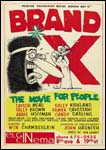|


|

|
 |
YEAR: 1970 ROLE: Unknown
DIRECTOR: Wynn Chamberlain
US PREMIERE: May 18, 1970 in New York
City
|
|
|
Plot Summary |
|
The film follows the on-and off-air
shenanigans of Wally Right, the manic head of a
television station. It takes on President Nixon, the
Vietnam War, sex, drugs, technology and advertising,
alternating between vignettes riffing on TV programming
— an exercise show, a soap opera, a financial report —
and Dadaist commercials like one for “Food,” in which
the film’s cinematographer, John Harnish, is seen
sitting with a naked blond woman at a table covered with
fruit. “Eat more, think less,” he quips to the camera.
Abbie Hoffman plays a corrupt cop who bathes in a tub
full of money; Taylor Mead portrays an indignant
American president holding a news conference; and Ultra
Violet gives an off-key performance on “The Tomorrow
Show.” |
|
Film Details |
Taylor
Mead
Sally Kirkland
Abbie Hoffman
Frank Cavestani
|
Tally Brown
Candy Darling
Sam Shepard
Ultra Violet |
|
Screenplay...........Wynn Chamberlain
Cinematography............John Harnish
Music.............................Ken Lauber
Length..............................87 minutes
|
|
|
Movie Still |
|

|
|
|
|
Production Notes |
|
“Brand X” was born on a snowy weekend in early
1969 in Staatsburg, N.Y., where Mr. Chamberlain and his
wife, Sally, had a weekend cottage. Sally recalls, “We
couldn’t get out; the only thing to do was watch
television, We hadn’t watched much daytime television,
and Wynn was immediately struck by its banality and
superficiality.” Mr. Chamberlain was by then an
established Pop-realist painter and a fixture in the New
York art scene, with work in the Whitney Museum of
American Art and what is now the Smithsonian American
Art Museum and a social set that included Allen
Ginsberg, Frank O’Hara and John Cage as well as Warhol
and the Factory denizens. He was also, like most of his
friends, enamored of the counterculture and dismayed by
the conservatism of mainstream culture, as embodied by
the television he watched that day. He wrote a script,
cast Mr. Mead as his lead and cobbled together $10,000
from supporters. Much of the rest of the cast came
together by osmosis.
The film was shot over several months in the spring and
summer, in and around places where the Chamberlain
family lived and worked: Bard College, where Mr.
Chamberlain taught art history; the Staatsburg house; a
loft in the Bowery building where he kept a studio. A
distribution deal was signed with New Line Cinema after
the initial run, and “Brand X” went on to tour several
college campuses.
On April 9, 2011, it was screened for the first time in
nearly 40 years, at the New Museum on the Bowery in NYC.
|
|
Reviews & Clippings |
|
Jonas Mekas, The Village Voice, May 14, 1970:
"Go to the Elgin Theatre early next week and see Wynn Chamberlain's 'Brand X'.
It's neither Jack Smith nor Ozu nor Jerry Joffen. It's completely somewhere
else. Probably I should consider it the first truly entertaining Entertainment
film of the new consciousness; or the first Entertainment film of the Woodstock
Nation; or maybe the Last Entertainment Film of the Nixon Nation. The film is
constructed as a TV program. It's funny from beginning to end. The imagination
that went into it is subtle and intelligent. The film is very well acted by
Tally Brown, Sam Shepard, Joy Bang, Sally Kirkland Frank Cavestani, Abbie
Hoffman and others, but it is Taylor Mead who steals the show in his numerous
impersonations. For the first time since Ron Rice, Taylor Mead seems to have had
in 'Brand X' challenges and tasks where he could really put his boundless
inventiveness to work and comes up with some of his best acting in years. The
film hits. It spoofs. It spits. It slashes and it lashes at all sides. And has a
feeling and energy about it that is healthy, confident, strong and accusing.
Brand X is propaganda for the politics of joy and disorder. 'Brand X' shines
like gold."
Raymond A. Sokolov, Newsweek Magazine, May 25, 1970:
"The people who made 'Brand X', Director Wynn Chamberlain, Cameraman John
Harnish and underground performers like Taylor Mead and Sally Kirkland know
where it's at; sexually, politically and pop culturally. They understand that
straight and kinky America exist side by side. What 'Brand X' does is bring the
two cultures together in an outrageously raunchy parody of normal television
programming. A hospital soap opera turns into an orgy on the patient's bed. A
commercial shows a classy red car cruising down a country road with a couple on
the hood making love. Abbie Hoffman of the Chicago Seven bathes naked in a
tubful of money. And a unisex paragon fools the panel on 'What's My Sex'…A
slapstick weather show, a lunatic Presidential press conference and a sermon
improvised by Taylor Mead could technically run on the air, but one knows they
never would. That is the brilliant fundamental joke of 'Brand X': it
transgresses the last taboo – the sanctity of the television tube."
Bobby Abrams, Crawdaddy, May 21, 1970:
"Wynn Chamberlain deserves every praise in the book, 'cause this is the
beginning of a new cinema. It's the application of Fellini to content. Whereas
the Italian filmmakers who came to prominence in the sixties concerned
themselves with style, (is Fellini hard to follow now? I suggest not), and
whereas the early underground filmmakers rarely created a satisfactory entity,
we now have a film maker who can handle poetry as texture, poetry as style and
poetry as meaning."
Lil Picard, Interview Magazine, May 1970:
"Bertold Brecht, while living in exile as a refugee from the German disaster,
wrote a poem whose first line reads, 'Really we are living in disastrous
times.'…It could be that 'Brand X' done in 1969 and shown in May 1970, will in
time become a Brechtian truth-comedy. The press conference with Taylor Mead as
President of the United States and Sally Kirkland as the soap bubbling, pouting,
golden haired star spangled-clad First Lady is prophetic indeed for many of the
things we are experiencing today."
Penelope Gillatt, New Yorker Magazine:
"Filthy, good-humored, crass."
Lita Eliscue, Los Angeles Free Press:
"'Brand X' is not only Healthy but Beautiful."
Archer Winsten, New York Post:
"Scenes of, 'doing it on the road' are enacted with a spirit that makes sex
education films seem positively anemic."
|
| |
| |
|